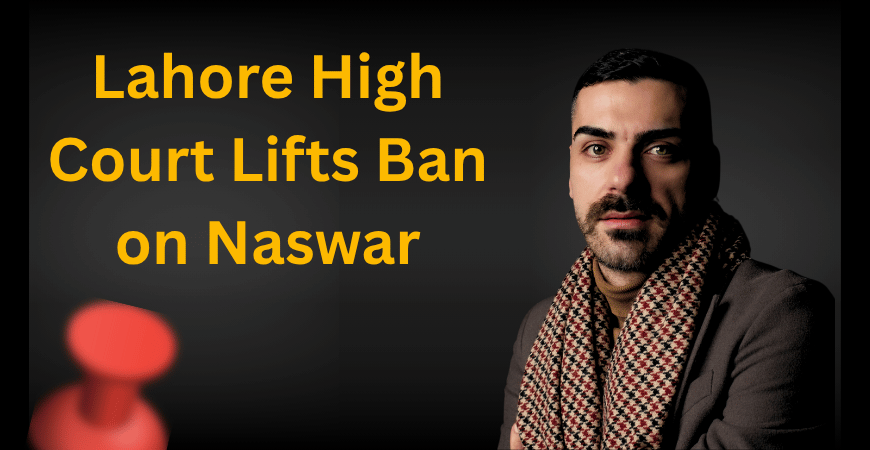Lahore High Court Lifts Ban on Naswar in Punjab
Impact After Lahore High Court Lifts Ban on Naswar
In a significant judicial ruling, the Lahore High Court’s Multan bench has officially lifted the prohibition on the manufacture, sale, and purchase of naswar in the province of Punjab. This decision reverses a long-standing restriction imposed by the Punjab Food Authority (PFA) that had designated naswar as a harmful substance.
Background: The Ban and Legal Challenge
The ban on naswar in Punjab stemmed from regulatory efforts led by the Punjab Food Authority, which had classified the product under categories of health risk. Over time, restrictions were imposed on its production, sale, and transit through various provincial notifications. The PFA’s stance was rooted in public health concerns, arguing that naswar (a form of smokeless tobacco commonly used in several parts of Pakistan) posed serious risks to users.
However, the legal challenge against the ban had persisted for years. The key case in the High Court is the Writ Petition No. 4177/18, which remained pending for nearly seven years. Petitioners contended that the ban violated constitutional rights to trade and personal choice, and that the regulatory framework was overreaching without adequate evidence and safeguards.
During this lengthy judicial consideration, the High Court had earlier issued a stay order on the PFA’s notification, effectively suspending enforcement of the ban while the case was adjudicated.
The Ruling: What Changed
On October 2, 2025, the Multan bench delivered its verdict, declaring that there shall be no ban on the manufacturing, sale, or purchase of naswar in Punjab. The bench, presided over by Justice Syed Ahsan Raza Kazmi, formally declared that previous restrictions must be withdrawn, restoring legal status to naswar-related commercial activities.
Notably, during hearings, the Punjab Food Authority reportedly indicated a willingness to withdraw the impugned notification. This position likely influenced the court’s decision to lift the ban, suggesting some administrative concession. MM News
From now on, naswar will be treated like any other regulated product, subject to applicable laws (e.g. health disclosures, packaging standards) but no longer under outright prohibition.
Implications of the Decision
For the Trade and Industry
The verdict is a major relief for traders, manufacturers, and supply chains dealing in naswar. For years, many small businesses and vendors faced uncertainty and risk of enforcement actions. With the ban removed, the sector can resume normal operations, renegotiate supply contracts, and invest in infrastructure without fear of sudden legal penalties.
Local producers may now scale up production or re-enter markets from which they had withdrawn. Suppliers of raw materials, packaging, and distribution services could see renewed business. However, regulators may impose standards or oversight to prevent misuse or harm.
Public Health and Regulatory Concerns
Lifting a ban on a tobacco product like naswar raises immediate public health questions. While the court’s decision restores legal rights of trade, it does not inherently remove obligations for health regulation. Authorities may still enforce restrictions on labeling, sale to minors, taxation, and quality control.
Critics may argue the decision weakens public health efforts aimed at reducing tobacco consumption. Proponents, meanwhile, might emphasize the court’s role in checking regulatory overreach and protecting commercial rights. Over time, the balance between trade freedom and health regulation will be tested through statutes, rules, and future litigation.
Legal & Constitutional Precedents
This ruling may set a precedent for similar challenges in other provinces or jurisdictions. When regulatory bans are challenged, courts will examine whether the statutory backing, procedural fairness, public notice, and evidence of harm were adequate. Policies that lack rigorous scientific basis or fail due process may be vulnerable.
Moreover, the court’s willingness to lift a long-standing ban after a stay period affirms that judicial patience and procedural fairness are vital in constitutional litigation.
Social and Political Reactions
The decision has already sparked reactions from diverse quarters—advocacy groups, trade bodies, public health organizations, and the general public. Supporters in the commercial sector are likely to herald it as a victory for business rights. Public health advocates may call for stringent regulatory frameworks to accompany the re-legalization.
Politically, the ruling could become a point of comparison for how regulatory policy is made and reversed. If government bodies reintroduce restrictive measures without due process or evidence, they may face fresh litigation.
What Comes Next
-
Legislative & Regulatory Review: The Punjab government and health authorities are expected to review related laws and regulations to align them with the court’s ruling. New rules may focus on labeling requirements, health warnings, age restrictions, quality standards, and monitoring compliance.
-
Public Awareness & Health Campaigns: Non-governmental organizations and health bodies may intensify efforts to inform citizens about the risks of naswar, especially in the absence of a ban.
-
Possible Appeal or Reconsideration: Though the High Court has ruled, there is scope for appeal (potentially to the Supreme Court) or further legal challenges in narrower aspects (e.g. localized prohibitions, transit bans, taxation).
-
Market Re-entry & Expansion: Firms that had scaled back or exited may re-enter. Investment in manufacturing, branding, and distribution will possibly rebound.
-
Monitoring & Enforcement: Regulatory agencies will need to develop enforcement mechanisms for any new rules (e.g. random checks, compliance audits) to maintain public health safeguards.
This judgment by the Lahore High Court’s Multan bench marks a turning point in the legal status of naswar in Punjab. While it restores commercial freedoms in this domain, it also places onus on regulators, health advocates, and the government to craft balanced laws that preserve public health without overstepping constitutional limits.
Read Also: P&G Shuts Down Operations in Pakistan – Official Update



